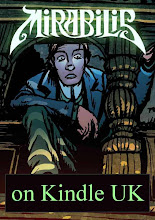 How do you create a monster? Victor Frankenstein isn’t telling. His excuse, eminently reasonable in light of how things turned out, is that he wants to prevent others from rediscovering the process. We're not sure if he's giving life or restoring it; we're left in the dark as to whether it involves sparks or smells or both. A possible clue: recounting his early influences, Victor mentions Paracelsus and other practitioners of alchemy and occultism. Benjamin Franklin and Luigi Galvani don’t get a look in.
How do you create a monster? Victor Frankenstein isn’t telling. His excuse, eminently reasonable in light of how things turned out, is that he wants to prevent others from rediscovering the process. We're not sure if he's giving life or restoring it; we're left in the dark as to whether it involves sparks or smells or both. A possible clue: recounting his early influences, Victor mentions Paracelsus and other practitioners of alchemy and occultism. Benjamin Franklin and Luigi Galvani don’t get a look in.“I pursued nature to her hiding-places. Who shall conceive the horrors of my secret toil, as I dabbled among the unhallowed damps of the grave, or tortured the living animal to animate the lifeless clay? […] I collected bones from charnel houses and disturbed, with profane fingers, the tremendous secrets of the human frame. […] The dissecting room and the slaughter-house furnished many of my materials; and often did my human nature turn with loathing from my occupation.”As John Sutherland wrote in his essay “How does Victor make his monsters?” there is nothing in the original novel that says the monster is a patchwork of body parts from rifled graves:
“It remains unclear whether [Victor’s] motive has been research into primal tissue, or the kleptomaniac filching of limbs and organs with which Fritz’s midnight forays in the films have made us familiar.”Fritz (the inimitable Dwight Frye) is of course a creation of the movies; in the novel, Victor has no assistant, hunchbacked or otherwise. The location he chooses for his second laboratory is a tiny island in Orkney, and he goes there alone. Unless he brings with him a stack of coffins, we can safely assume that no corpses are harmed in the making of the second (female) monster. Certainly the island’s population cannot provide Victor with raw materials – there are only three cottages, one of which he rents. No cemetery or morgue is mentioned, supporting the theory that he constructs or even grows the bodies before animating them.
Mary Shelley may have drawn her inspiration for Victor from her husband’s enthusiasm for amateur science. Three or four years before Percy Shelley met Mary Godwin, his friend Hogg described his room at Univ:
“Books, boots, papers, shoes, philosophical instruments, clothes, pistols, linen, crockery, ammunition and phials innumerable, with money, stockings, prints, crucibles, bags and boxes were scattered on the floor and in every place, as if the young chemist, in order to analyse the mystery of creation, had endeavoured first to re-construct the primeval chaos. The tables, and especially the carpet, were already stained with large spots of various hues, which frequently proclaimed the agency of fire. An electrical machine, an air-pump, the galvanic trough, a solar microscope and large glass jars and receivers, were conspicuous amidst the mass of matter.”It seems that Victor is a (bio)chemist, not an engineer or physicist. The only reference in the original text that justifies the leaping, coiling, thrilling bolts of electricity that arced above Colin Clive and Boris Karloff is where Victor says, “I collected the instruments of life around me, so that I might infuse a spark of being into the lifeless thing that lay at my feet.” The rest of the passage describing the monster’s birth is tragic rather than climactic. He seems to slip reluctantly into the land of the living, and Victor has no exultant shout of “It’s alive!” His mood is one of anxiety, hopelessness and disgust.
Disgust is a big part of Victor’s relationship with the monster, a disgust evidently born of self-loathing. Novels are not literal, of course, so we need to remember that on another level the monster is Victor – the side of him that leers with “a ghastly grin” when he shapes the female creature’s flesh under his hands. Victor even describes him as “my own vampire, my own spirit let loose… forced to destroy all that was dear to me.” He is a proud, lustful, physical creature who makes a stab at pretending to be civilized. As do we all.
And what about that grin? How exactly is it “ghastly”? There’s no spare part surgery in Mary Shelley’s book; if Victor isn’t a physicist, still less is he a surgeon. And, however Shelley envisaged the monster, she surely meant him to be stranger and more disturbing than Robert De Niro criss-crossed with catgut sutures:
“His yellow skin scarcely covered the work of muscles and arteries beneath; his hair was of a lustrous black, and flowing; his teeth of a pearly whiteness; but these luxuriances only formed a more horrid contrast with his watery eyes, that seemed almost of the same colour as the dun white sockets in which they were set, his shrivelled complexion, and straight black lips.”I don’t think an actor in make-up is going to cut it. People who encounter the monster react with fear and loathing – not, “Look at that poor chap,” but “Kill it! Kill it!” He must be terrifyingly deformed. In my version of the book, his skin is grown on frames similar to the ones that Victor’s cousin/fiancée uses for needlework, and it is literally transparent - a bug that Victor decides is a feature, as it will make it easier for anatomists to study the internal organs of his creation.
My Victor is a chemist and physicist - not terms that were actually used in English until the mid-1800s, but it’s all a translation, after all. He studies a little anatomy, and later has the chance to practice surgical techniques under the tutelage of Dr Robert Campbell. (If you convince Victor to do that, it means he is able to make the second creature far comelier than the first.) When we meet him, he’s collecting guillotined heads – but not to bolt onto his monster. He just wants to study the structure of a larynx so that he can replicate it:
“I need the small cartilages of a human voice box – a very intricate structure, much too time-consuming for me to build by hand. If I can find one fresh enough, chemicals can be used to stimulate its growth to suit the creature’s scale. Or perhaps I’ll use it to make moulds in which I can nurture bone cultures. There are a thousand excruciating details like this.”Soon after, Victor talks about the monster’s brain:
“The structure of the brain is far beyond my power to replicate, so I implanted tissue from the brains of several unborn children, bathed in certain internally secreted chemicals that appear to stimulate growth, and grafted this to a fully developed brain stem. Thus the creature will be born with an infant mind, but the mind should mature at a greatly accelerated rate. As to the nature of its thoughts and feelings – they may be like yours or mine, or they may be something entirely new.”I have provided more details of the monster’s creation than Mary Shelley did. Readers today will expect some flesh on the bones. The story has become very familiar, from books and movies and plays, and so it’s necessary to push a little if it is still to have power to surprise and shock, but hopefully I’ve kept some of the ambiguity and mystery. I want you to read into the creation process your own private horrors. James Whale made the moment cinematically exciting, but in doing so he lost the most important aspect of Victor’s solitary act: the fact that it is unbearably sad and rather squalid. The desperate loneliness of the staring animal eye, the sudden intake of breath, the reflexive shudder – all for something that can be achieved more wholesomely outside the workshop of filthy creation.
“So it will learn?” you (it's an interactive novel) may ask Victor.
“It is learning already. The brain is active, though sleeping as in the womb. Perhaps it can even hear what we're saying.”
Frankenstein is published by Profile Books. Now on sale in the App Store.























Years later, Mrs Shelley had this to say about her eureka moment at the Villa Diodati:
ReplyDelete"Night waned upon this talk, and even the witching hour had gone by, before we retired to rest. When I placed my head on my pillow, I did not sleep, nor could I be said to think. My imagination, unbidden, possessed and guided me, gifting the successive images that arose in my mind with a vividness far beyond the usual bounds of reverie. I saw -- with shut eyes, but acute mental vision, -- I saw the pale student of unhallowed arts kneeling beside the thing he had put together. I saw the hideous phantasm of a man stretched out, and then, on the working of some powerful engine, show signs of life and stir with an uneasy, half vital motion. Frightful must it be; for supremely frightful would be the effect of any human endeavour to mock the stupendous mechanism of the Creator of the world."
See that? "The thing he had put together..." But I don't count that as evidence of Victor having assembled the monster for spare parts for two reasons. First because Mrs Shelley cooked up this reminiscence 15 years later - hence all the twaddle about science mocking the Creator.
In any case, even if it is genuinely how she conceived of the monster originally, *it's not part of the text*. What authors say outside of the novel itself is no more relevant than anyone else's opinion. They're often not aware of what they've left out or why. Trust me, I should know.